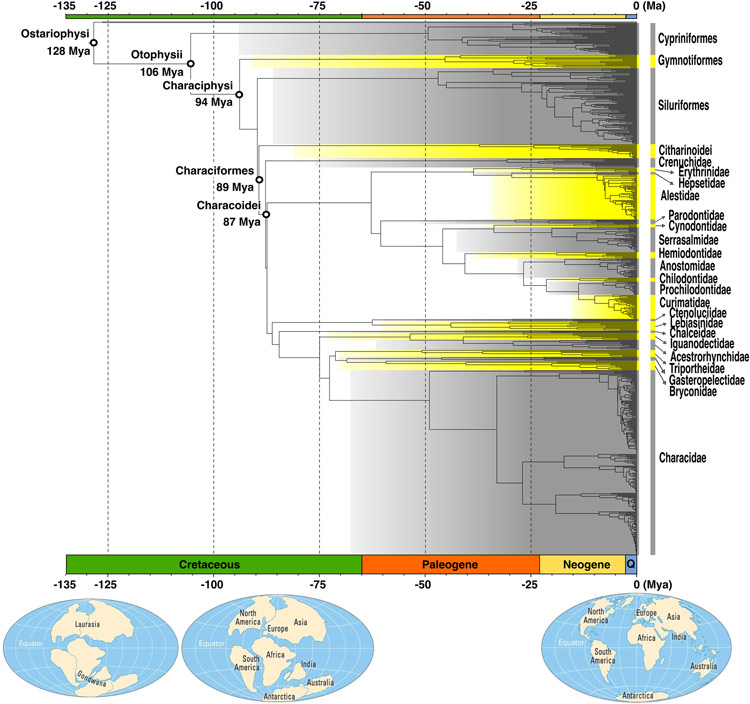November 2025: publication Ecology and Evolution
Early Biogeography of Otophysi Points to the Neotropics as the Cradle of Characiphysan Fishes
Freshwaters represent less than 1% of Earth’s surface and only 0.02% of the available aquatic habitable volume, yet they host nearly half of the 35,500 known species of bony fishes. Ostariophysan fishes account for 70% of all freshwater fish diversity, comprising approximately 12,000 species across five highly speciose orders. They represent a major evolutionary radiation, the internal phylogenetic relationships of which remain the subject of intense debate. To better understand their early evolutionary history and origin, we reconstructed their phylogeny using dense taxonomic sampling and a combined dataset of complete mitochondrial genomes and sequences from four nuclear genes. Phylogenetic relationships and divergence times were inferred using Bayesian and Maximum Likelihood approaches and molecular dating analyses on a dataset of 687 ostariophysan species, comprising 21,701 aligned positions, including 15,707 variable sites. We also applied model-based Maximum Likelihood ancestral area reconstruction to investigate the early evolutionary history of Otophysi. Our analyses yielded a highly supported phylogenetic hypothesis for Otophysi, highlighting the role of plate tectonics in driving multiple divergence events, along with subsequent range shifts. These findings are further supported by the contraction of the tropical belt, which began at the end of the Cretaceous and continued throughout the Paleogene. Our results support the divergence of Cypriniformes and Characiphysi as a consequence of the breakup of Laurasia and Gondwana. The origin of Characiphysi is traced to West Gondwana, and the subsequent expansion of the group cannot be explained without invoking transcontinental dispersal during the Upper Cretaceous-Paleocene.

Fig. 3: Time tree estimated using 11 fossil calibrations (Table 1) with a discrete model and λ = 10. The nodes associated to the origin of Ostariophysi (128 Ma), Otophysii (106 Ma), Characiphysi (94 Ma), Characiformes (89 Ma) and Characoidei (87 Ma) are highlighted with black circles.
References
Lenglin A., Hidalgo M., Miranda G., De la Sota A., Caminade P., Belkhir K., Otero O., Antoine P.-O., Garcia-Davila C., Hubert N. 2025 – Early Biogeography of Otophysi Points to the Neotropics as the Cradle of Characiphysan Fishes – Ecology and Evolution, 15:e72431 – Doi.org/10.1002/ece3.72431




